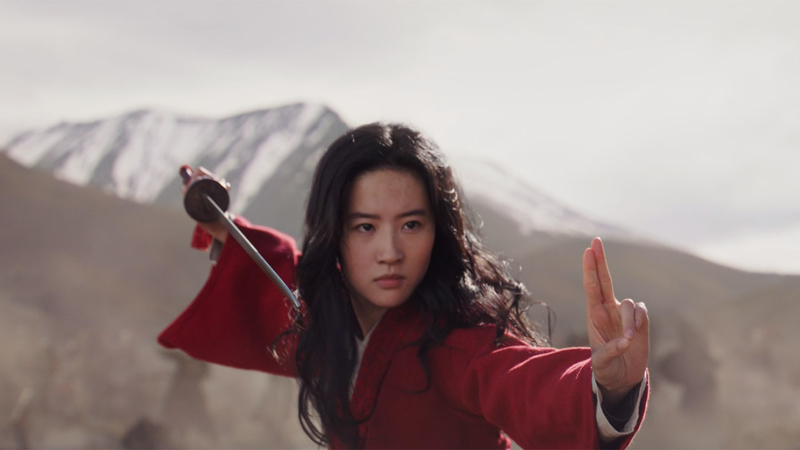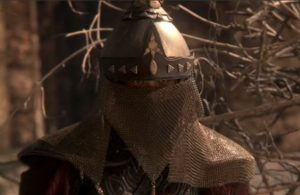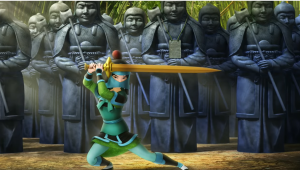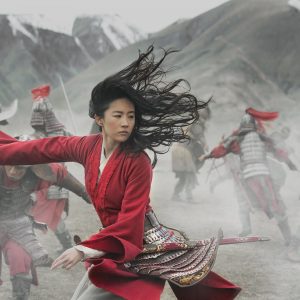
The recent release of the live action Mulan has generated a buzz on whether this new film’s plot and character changes constitute a step forward or a step back for women.
Filmmakers made the controversial decision of cleaving Li Shang’s character in two. Her romance with a commanding officer was seen as a problematic power dynamic, though both the animated Mulan and the live one had very little actual romantic interaction with him due to her cross-dressing. The new film features a blunt shoutout to the #MeToo movement, with male soldiers chorusing “We believe Mulan” (about the invasion, thankfully, not assault). Most significantly, this Mulan chooses to reveal her gender herself rather than being discovered through injury. But this self-unveiling has already been done twice in Disney television, and neither instance was empowering.
The FTTV project primarily tracks fairy tale adaptation in television, not just film. Though she has a presence in Chinese TV, Mulan’s presence in Western television in our current database is limited only to Disney affiliate shows. She appears in Once Upon A Time and Sofia the First. Both inclusions feature awkwardly shoehorned sexism that doesn’t make sense in the overall feminist contexts of both shows.
Once Upon A Time stars the rough, competent Emma Swann, a bail bondswoman turned sheriff. Emma’s mother, Snow White, is a capable warrior who leads a band of outlaws, and, later, her country. But after a solid first season establishing warrior femininity as a cultural norm in the Enchanted Forest, the opening episode of the second season introduces Mulan as a veiled, helmeted warrior. It’s obvious enough to the audience that we’re watching a woman walk around on screen, but Princess Aurora assumes her to be a man until she removes her helmet. Aurora, Mulan, and Prince Phillip then have the following dialogue:
Aurora: You’re a girl?
Mulan: Woman. My name is Mulan.
Phillip: In your absence, she has helped me like no other. We’ve fought many battles together.
Aurora: With a woman.

A woman warrior? Gasp!
This unveiling dismantles the gender equality the first season of Once Upon A Time set up so thoroughly. Why should Mulan’s warrior status come as such a surprise when Snow White (and many other princesses introduced later) are regularly seen in action? It’s not standard for woman warriors in this show to go veiled. But because Mulan’s tale is rooted in gendered themes, sexism is injected into the otherwise gender-progressive Enchanted Forest to justify her story.
Similar sexism problems arise when Mulan guest stars in an episode of Sofia the First. Eight-year-old Princess Sofia and her gal pals regularly save the kingdom of Enchancia with the help of Sofia’s magical amulet. Sometimes, the amulet summons adult princesses to give her guidance. On a trip to the China-inspired kingdom of Wei-Ling, Sofia and the Wei-Ling princess, Jun, are left behind when their brothers go treasure hunting. The girls’ fathers set out to stop the boys before they encounter the dangerous Jade Jaguar that guards the treasure. When Sofia learns her brother is in danger, she offers to go with. But the emperor of Wei-Ling tells her, “This is far too dangerous for princesses.”
This is followed by a scene cut where their brothers gleefully speculate on the dangers that await them in the treasure cave, bragging, “A couple of princes like us should have no problem figuring it out.” Prince and princess are used as not-so-subtle replacements for “boy” and “girl.” Age, quite frankly, would be a fitting justification for why the eight-year-old girls should stay behind, but gender is cast as the problem to lay the grounds for Mulan’s appearance.

Both their brothers and fathers soon fall victim to a booby trap, leaving the princesses the only ones to rescue them. They encounter magical statues blocking the path to the cave and can’t find a way around them. Mulan then shimmers into existence, decked out, once again, in a helmet. She takes it off in a matter of seconds, so it’s clearly worn for neither defense nor disguise, but to force an unveiling. A woman warrior? Gasp!
She shows the girls how to climb overhanging vines to bypass the statues and save their menfolk. A grateful emperor then tells them, “I know I said this journey would be too much for you girls, but clearly, I was mistaken. Today you have proven yourselves to be smart and brave.”
Actually, they prove that every day.

This episode’s title? “Princesses to the Rescue!” This title could really be applied to any episode of the series. Sofia the First consistently teaches young girls that plucky, spunky, adventuring princesses can save the day. Injecting artificial sexism into a world without it to “empower” girls can have a nasty reverse effect. Subverting gender expectations is not empowering to a preschool audience because little girls don’t know these norms exist yet-until this Mulan episode teaches them. Before she takes leave of the young princesses, Mulan tells Sofia, smugly, “I believe there are some kings and princes that need rescuing,” implying that girls saving the day is not a cultural norm.
Because Disney versions of Mulan’s story depend so much on sexism, she can’t be included in any other princess universe without hurting the rest of princesskind. In a movie by herself, she functions as an empowering icon. But introducing her into a gender-progressive setting immediately sets the whole fictional universe back.

How does Mulan compare to other women in her 2020 film? In the 1998 cartoon, she was the only young woman character. Now she’s joined by a sister and a sorceress. Her sister, Xiu, serves as a foil, following gender norms and making a marriage match while Mulan is off winning a war. Xianniang is an outcast of society, scorned as a witch, serving as a lackey under Bori Khan. She tells Mulan, who also has magic (called qi) that she will never be accepted for her power and gender.
Is there a reason rooted in Chinese culture for women not to use qi? Not really. Qi is a facet of the body, a kind of life force. Writings about qi were written and read by men, so technically the subject of a qi text could be assumed to be male. But it’s no less gender-specific than the blood in your veins or the air in your lungs.

Mulan, of course, proves sorceress Xianniang wrong. When she finally unveils herself, her comrades are more concerned about her being a female soldier than a woman who uses qi. Mulan ends up victorious, Xiu ends up matched, and Xianniang ends up dead.
By magicking Mulan, filmmakers have instantly set her apart from other women, both in the film and in the audience. The cartoon Mulan came to strength with the rest of her army. In my early teens, when I began to look critically at my childhood favorite princess, I thought this was awfully empowering. I got to see her start off just as weak as I would’ve been if I ran off to join the military and then grow strong. 2020 Mulan is “not like other girls.” She has magical super strength that gives her a leg up in military matters. Ordinary females, whether they’re the age of Sofia the First or Emma Swann, can’t relate to that.
There is much that is brave, virtuous, and empowering about the various incarnations of Mulan, including this new, live-action Disney one. She shows tremendous strength of body, mind, and character. But even as Mulan takes control of her gender by unveiling herself, one message is clear: for Mulan to be empowered, other female characters can’t be.